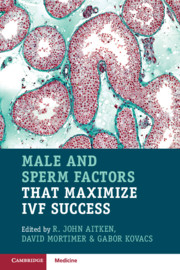Book contents
- Male and Sperm Factors that Maximize IVF Success
- Male and Sperm Factors that Maximize IVF Success
- Copyright page
- Contents
- Contributors
- Chapter 1 Sperm Selection for ART Success
- Chapter 2 New Horizons in Male Subfertility and Infertility
- Chapter 3 Chromosome Abnormalities and the Infertile Male
- Chapter 4 The Effect of Endocrine Disruptors and Environmental and Lifestyle Factors on the Sperm Epigenome
- Chapter 5 Lifestyle Factors and Sperm Quality
- Chapter 6 The Effect of Age on Male Fertility and the Health of Offspring
- Chapter 7 The Assessment and Role of Anti-sperm Antibodies
- Chapter 8 FSH Treatment in Male Infertility
- Chapter 9 Antioxidants to Improve Sperm Quality
- Chapter 10 The History of Utilization of IVF for Male Factor Subfertility
- Chapter 11 The Case Against Intracytoplasmic Sperm Injection for All
- Chapter 12 Perinatal Outcomes from IVF and ICSI
- Chapter 13 Artificial Insemination with Partner’s Sperm for Male Subfertility
- Chapter 14 Obstructive Azoospermia: Is There a Place for Microsurgical Testicular Sperm Extraction?
- Chapter 15 Should Varicocele Be Operated on Before IVF?
- Chapter 16 Donor Insemination: Past, Present and Future Perspectives
- Chapter 17 DNA Damage in Spermatozoa
- Chapter 18 Prevention of Male Infertility: From Childhood to Adulthood
- Index
- References
Chapter 11 - The Case Against Intracytoplasmic Sperm Injection for All
Published online by Cambridge University Press: 24 May 2020
- Male and Sperm Factors that Maximize IVF Success
- Male and Sperm Factors that Maximize IVF Success
- Copyright page
- Contents
- Contributors
- Chapter 1 Sperm Selection for ART Success
- Chapter 2 New Horizons in Male Subfertility and Infertility
- Chapter 3 Chromosome Abnormalities and the Infertile Male
- Chapter 4 The Effect of Endocrine Disruptors and Environmental and Lifestyle Factors on the Sperm Epigenome
- Chapter 5 Lifestyle Factors and Sperm Quality
- Chapter 6 The Effect of Age on Male Fertility and the Health of Offspring
- Chapter 7 The Assessment and Role of Anti-sperm Antibodies
- Chapter 8 FSH Treatment in Male Infertility
- Chapter 9 Antioxidants to Improve Sperm Quality
- Chapter 10 The History of Utilization of IVF for Male Factor Subfertility
- Chapter 11 The Case Against Intracytoplasmic Sperm Injection for All
- Chapter 12 Perinatal Outcomes from IVF and ICSI
- Chapter 13 Artificial Insemination with Partner’s Sperm for Male Subfertility
- Chapter 14 Obstructive Azoospermia: Is There a Place for Microsurgical Testicular Sperm Extraction?
- Chapter 15 Should Varicocele Be Operated on Before IVF?
- Chapter 16 Donor Insemination: Past, Present and Future Perspectives
- Chapter 17 DNA Damage in Spermatozoa
- Chapter 18 Prevention of Male Infertility: From Childhood to Adulthood
- Index
- References
Summary
While intracytoplasmic sperm injection (ICSI) is the most significant advance in assisted reproductive technology (ART) for the alleviation of male factor subfertility, its use has become increasingly widespread and indiscriminate in ART clinics, extending well beyond the reasons for its necessary application. But ICSI is not “better” than IVF using any established outcome metric. Indeed, available evidence indicates that ICSI yields fewer embryos per treatment cycle, embryos which may have impaired developmental potential compared to IVF-derived embryos. This chapter investigates the basis for the over-use of ICSI, and identifies risks to which couples are exposed by the unjustified use of ICSI: a debate that has been raging for two decades, and is now also extending into considerations of “andrological ignorance”, how ICSI has effectively blocked scientific advances in andrology, and how obligate ICSI has effectively transferred the treatment burden for male factor infertility to the female partner, who is expected to undergo possibly unnecessary controlled ovarian hyperstimulation, oocyte retrieval and embryo transfer procedures.
- Type
- Chapter
- Information
- Male and Sperm Factors that Maximize IVF Success , pp. 130 - 140Publisher: Cambridge University PressPrint publication year: 2020
References
- 1
- Cited by



